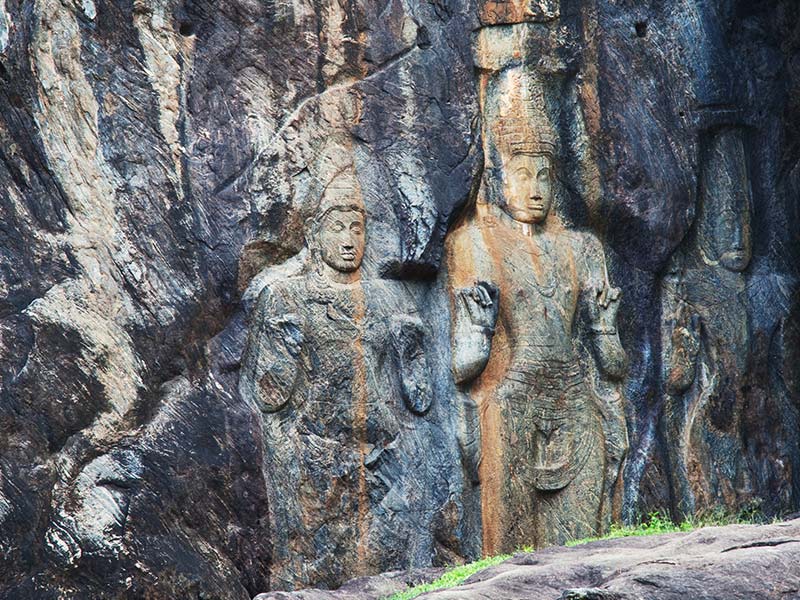The Buduruvagala-meaning “rock with Buddha images”-temple complex just four miles southeast of the town of Wellawaya, in the Monaragala District. Buduruvangala rock carvings is an incredible Buddhist archaeological site that dates back to the late Anuradhapura period, at least during the Tenth Century AD. The Polonnaruwa Kingdom had not yet been founded and Anuradhapura itself was on its last, shaky legs with weak kings and foreign invasions. Not much about is known of Buduruvangala rock carvings and indeed there are hardly any historical records of the place, just that it is important to scholars of the other Buddhist sect. The rock itself supposedly resembles the figure of a kneeling elephant, trunk in its mouth and this is only the beginning of the splendor of the place. It is one of the lesser known historical places in the country but is also one of the most spectacular.
It is unique for showing us a glimpse of Mahayana Buddhism, as opposed to the more common Theravada. Indeed this school of Buddhism has been around in Sri Lanka for centuries, albeit the more orthodox Theravada sect-which obtained royal sponsorship-was strictly against it. Yet for a brief time as Anuradhapura weakened, this form started to take over in a brief period of flowering. As Mahayana advocates the belief in the godlike Bodhisattvas as well as the Buddha himself, it is the chief of the former, the Bodhisattva Avalokitesvara, who is represented in the numerous carvings at Buduruvangala rock carvings. They are sculpted directly into the rock and each statue has incredibly delicate features, especially visible in the androgyny of the Bodhisattva images and those of the other deities.
In his Theravada form, he is worshipped as Lord Natha, one of the Satara Varam Deiyo.
There is yet another connection to the other Buddhist school in the form of Maitreya Buddha, the legendary Buddha-aspirant who dwells in the highest level of the heavens and will be born in the mortal world to guide mankind in the far future.
Among the other deities at Buduruvangala rock carvings is the merciful goddess Tara, faithful consort of the Bodhisattva. Her figure is painted in white, and these two are part of seven massive statues staring at visitors from the rock-face. She is also a goddess who gave strength to women and guidance during times of disaster. She stands clearly against the other figures, in between her husband and the Prince Sudhana, and at a slightly higher level than them. The most impressive figure in the complex is a veritable colossus of a Buddha image, showing him at fifty-one feet high. It is the tallest in the island. The details of the image lack the crispness of the Avukana image or those at Galvihara at Polonnaruwa but it is similar to the former in general physique, at least at a casual distance.
The Buddha stands with his hand held out in a gesture of ready openness, while his features are slightly flatter and squarer than most related images, especially in the details and shape of his face and shoulders. We know that these images were once brightly colored because the goddess Tara’s halo is a bright red and due to the streak of orange paint smattered across the Buddha’s robe. The queerest feature here is a “lamp” cut into the rock which has mustard oil dripping into it, suffusing the air with its smell. It was meant as a blessing to devotees while they presented themselves to Tara.
Written by Vasika Udurawane for Travel Lanka Compass



0 Comment